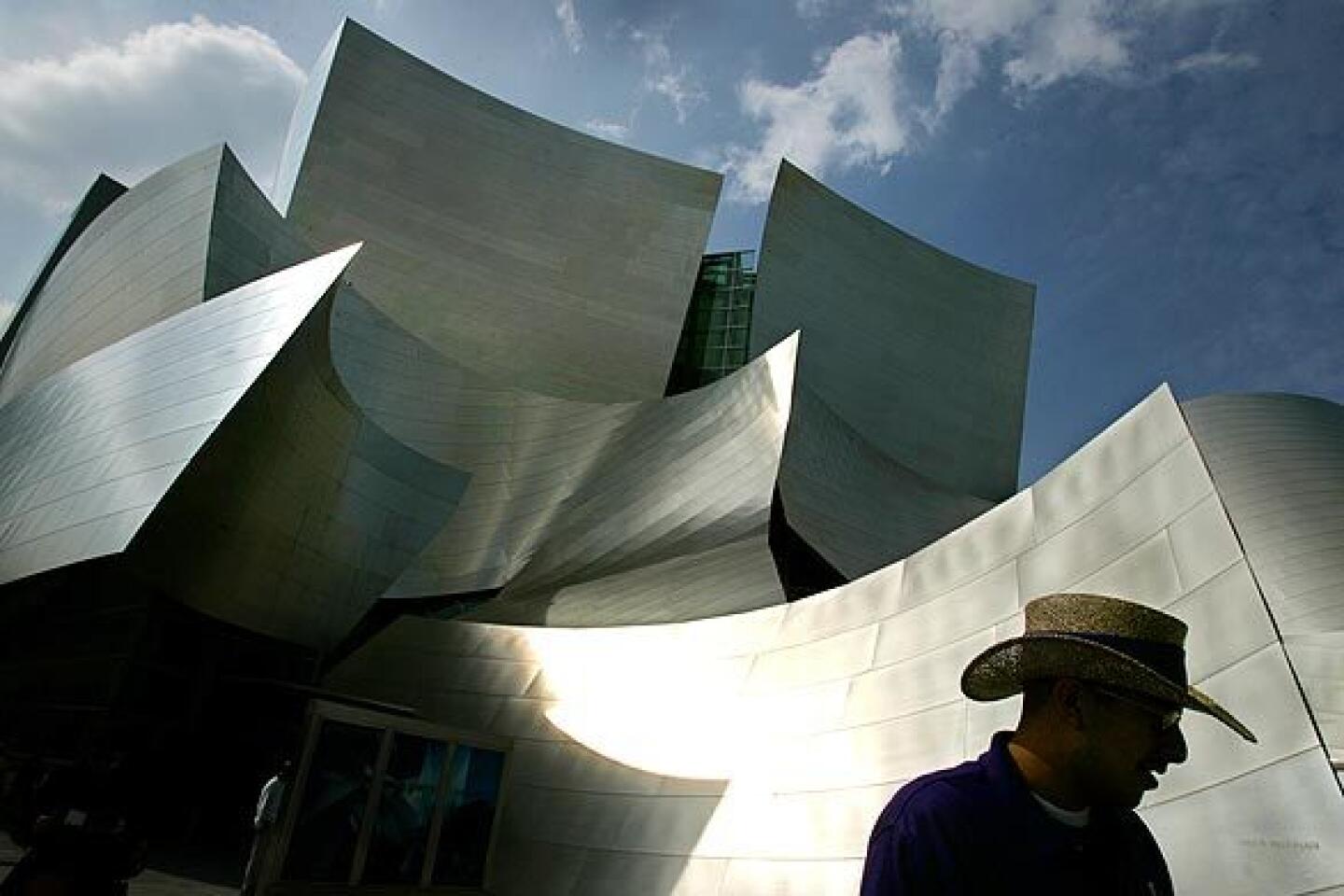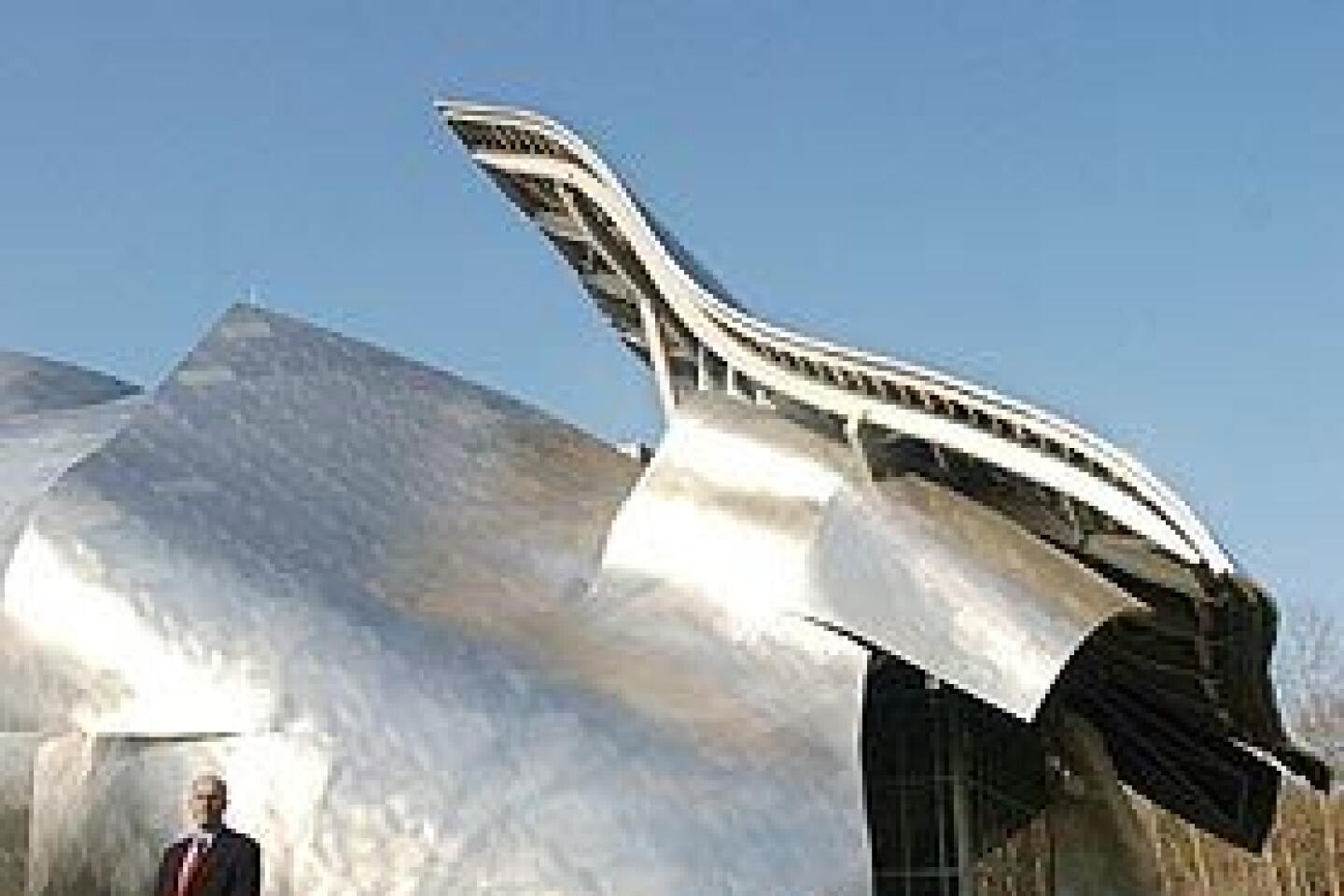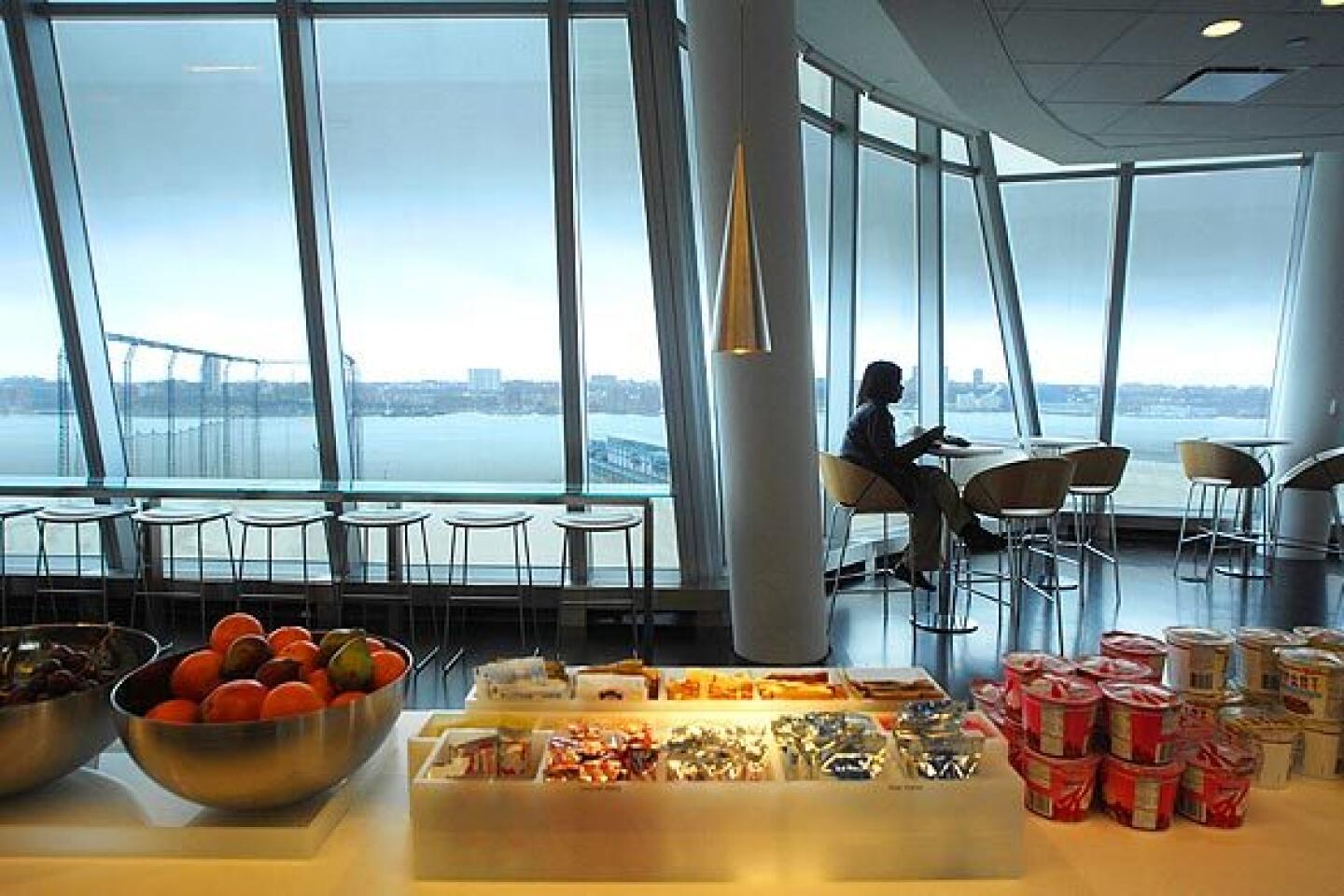Frank Gehry considers an accomplished past and uncertain future
- Share via
Frank Gehry, who turned 80 on Saturday, is the most famous architect in the world by a healthy margin. He is also, arguably, the most significant talent in American architecture since Frank Lloyd Wright. His firm, Gehry Partners, has streamlined a process in which his free-flowing sketches are turned into digital designs and then into dazzlingly unorthodox buildings around the world.
The success of Walt Disney Concert Hall, an acoustical and architectural triumph, has solidified his sometimes rocky relationship with Los Angeles, where he arrived with his family from Toronto in 1947 as a teenager. He has become a surprising pop-culture icon, designing a jewelry line for Tiffany and starring in a documentary by the late Sydney Pollack and in cartoon form in an episode of “The Simpsons.” He remains engaged in a range of new work, designing a huge branch of the Guggenheim Museum for a waterfront site in Abu Dhabi and fine-tuning a proposal that is among four finalists for the Dwight Eisenhower memorial in Washington, D.C.
And yet if Gehry now stands atop a mountain he spent much of his career trying to ascend -- driven by a fierce ambition he has often tried to conceal beneath what he calls an aw-shucks persona -- he does so at a moment when the mountain itself is beginning to crumble beneath his feet. After a decade in which a handful of leading architects became global stars -- with Gehry leading the charge -- and private and government clients alike were willing to finance jaw-dropping feats of architectural innovation, funding for new construction has suddenly vanished, as if overnight.
Most distressing of all for Gehry, two projects that he saw as capstones to his career, gigantic mixed-use developments on L.A.’s Grand Avenue and at Brooklyn’s Atlantic Yards, have both been put on hold.
“I’ve had a disappointing year, couple of years, with Grand Avenue and Brooklyn,” he said in a wide-ranging conversation in his office last week in which he was by turns ruminative, weary and hopeful. “All my life I’ve wanted to do projects like that, and they never came to me. And then all of a sudden I had two of them. I invested the last five years in them, and they’re both stopped. So it leaves a very hollow feeling in your bones.”
In response to the global slowdown, Gehry, like many of his peers, has been forced to radically cut his staff, which he said is now half the size it was just a year ago. In a broader sense, the virtuosic approach to design that Gehry has embodied since his Guggenheim Museum in Bilbao, Spain, opened to rapturous acclaim in 1997 faces an increasingly pointed critique within his profession.
For young architects, the way Gehry has organized his office and integrated new technology remains an inspiration. But for some of them, his recent work also represents the excesses of a decade that combined easy money and architectural celebrity. They are less interested in the bravura, photogenic icons that Gehry has lately produced -- so-called signature buildings by a so-called starchitect -- and more compelled by eco-friendly designs or anti-poverty efforts such as those aimed at providing affordable housing in rural areas. Other young architects are looking beyond the star model of architectural practice and toward communal, even anonymous, design initiatives.
Much of that shift is unsurprising, even predictable: a generational changing of the guard. But the extent of Gehry’s global prominence over the last decade and the speed with which the credit crunch has choked off building plans are both unique in the history of architecture. For a while, it seemed Gehry could hardly hire new staff quickly enough, and the building models in his studio -- this one slated for Panama, that one for Princeton -- were almost literally piled atop one another. The office now seems quiet.
And Gehry is clearly stung by the charge that his most mammoth projects -- the Brooklyn development, in particular, which was originally planned to include as many as 16 towers -- have been vehicles for self-aggrandizement forced on unwilling communities. After all, he has long painted himself as a lonely talent pushed to the periphery of the profession in the early decades of his career by myopic developers and less-principled colleagues.
In his mind, he doesn’t run roughshod over the little guy, as he has been accused of doing by neighborhood activists in Brooklyn. He is the little guy.
Given recent setbacks, he said, he is glad he accepted the commission in Abu Dhabi. His sprawling new Guggenheim, which he insists remains on track, is one anchor of a proposed cultural district called Saadiyat Island that would jut dramatically into the Persian Gulf. He is clearly thrilled to be working again with Thomas Krens, the former Guggenheim Museum director now spearheading the Abu Dhabi development.
“I was reluctant at first to do it,” Gehry said. “I thought, ‘I don’t want to go there now. It’s too far, it’s a new culture, I’m too old to get into it.’ And Krens prevailed and got me to go. And you know, if I hadn’t taken that job, the office would be a lot smaller today. It may very well help me get through this downturn.”
At 80, Gehry remains a hungry consumer of new ideas and images and remains noticeably sensitive to perceived slights -- retaining the chip on his shoulder that has long provided him with a competitive edge over more sanguine peers.
Though he said he makes an effort not to spend too much time dwelling on the past or thinking about how his partners might get along without him, he hasn’t been able to banish such notions altogether. He acknowledges that he worries about what will become of his office without him and that he is actively considering various options for the future shape of Gehry Partners.
“I try not to look back,” he said. “There’s not much use in that. But when you get to my age, you get anxiety about succession.”
In certain ways, Gehry is better positioned than most of his famous globe-trotting colleagues to handle the economic crisis and the lower budgets and smaller staffs that come with it. He sheathed his early houses and commercial projects, after all, with provocatively cheap materials. Riffing on the messy, vital work of Robert Rauschenberg and other artists, he built his reputation one section of chain link and one sheet of corrugated metal or cardboard at a time. In 1978, Gehry recalled, he decided to walk away amicably from his biggest client, the Rouse Co., and in an effort to start fresh slashed his staff from roughly 50 architects to three.
“I’m prepared to do that again, if I have to,” he said. “Today, if there’s frugality, I’m ready. I’ll do corrugated again. It’s fun to work that way, and it’s easy. Why spend all the money for fancy details and stuff? You don’t need it. You can get the passion with simpler things.”
Still, the size of the firm over the last several years was no accident: Gehry wanted the office to be a behemoth with global reach, and he drove it toward that goal.
In other ways too, Gehry is making concessions to the current moment and to his age. He said he has abandoned plans to build a house for himself and his family on three contiguous lots in Venice, despite having worked on the design of the compound intermittently but intensely over several years. Instead, he said, he is going to divide up the parcels -- giving one to his son Sam, who has been working in the Gehry Partners office, and one each to a pair of young architects in the firm, Meaghan Lloyd, currently his chief of staff, and Anand Devarajan.
He and his wife, Berta, will stay, he said, in the modest bungalow on 22nd Street in Santa Monica that he famously and radically reworked in the late 1970s -- just about the time, not coincidentally, that he was cutting ties with Rouse and making an effort to begin his career anew.
It is dawning on him, he said, that he is unlikely to realize a long-standing dream of moving to Paris.
“I love going to Paris, and I keep fantasizing that I’ll move there for the last years of my life. But I don’t know if I can do it. I think I’m stuck here, on 22nd Street in Santa Monica.”
Wherever he winds up, his legacy appears secure -- particularly as it relates to Los Angeles. Great architects preceded him here, of course, including Charles and Henry Greene, Richard Neutra, Rudolf Schindler and others. But if those architects, with strong links to styles pioneered elsewhere, brought the world to Los Angeles, Gehry has done the opposite. By designing projects on several continents rooted in the loose, informal aesthetic of his adopted hometown, he has delivered Los Angeles to the world.
christopher.hawthorne@latimes.com
More to Read
Sign up for Essential California
The most important California stories and recommendations in your inbox every morning.
You may occasionally receive promotional content from the Los Angeles Times.

















